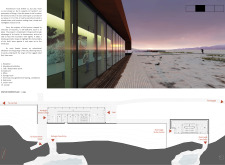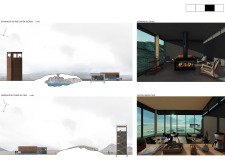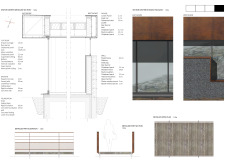5 key facts about this project
This architectural project represents a dialogue between the built environment and its natural surroundings, drawing inspiration from the topography and the unique characteristics of the site. The concept of two lines intersecting—a visual metaphor of the sky meeting the earth—serves as a guiding principle throughout the design. This approach results in a structure that appears to emerge organically from the landscape, reflecting the geological processes that have shaped the region over countless years.
Functionally, the visitor center is designed to accommodate various activities, including educational exhibits, community gatherings, and individual reflections. By providing spaces that cater to both collective and personal experiences, the architecture encourages visitors to engage actively with their environment. The layout is carefully organized to facilitate smooth movement through different zones, such as exhibition areas focused on Kvennagjá and Karlagjá geological features and observation points offering sweeping views of the natural vistas.
Key components of this project include the use of materials that resonate with the landscape. Corten steel forms the structure's façade, chosen for its ability to weather gracefully and blend with the surrounding earth tones. Wood accents add warmth, enhancing the interior ambiance and reflecting the organic quality of the nearby forests. Extensive glass panels are strategically placed to maximize views, allowing natural light to penetrate the space while blurring the lines between indoors and outdoors. The use of concrete provides necessary structural integrity, ensuring the building's longevity in the face of environmental challenges. Additionally, gabions—wire mesh baskets filled with stone—help stabilize the landscaping while echoing the geological elements present in the region.
The design of "Two Lines Dancing" stresses sustainability, employing geothermal heating systems and utilizing rainwater management techniques to minimize environmental impact. By integrating these systems, the project not only serves its immediate function but also aligns with broader ecological considerations, making it a responsible architectural intervention.
What sets this project apart is its unique ability to serve as both an educational platform and a welcoming space for exploration. The visitor center encourages visitors to immerse themselves in their surroundings, with outdoor pathways leading to significant geological sites, creating an enriching experience that blends nature with human activity. The observation tower, a standout feature, not only affords breathtaking views but also symbolizes the connection between humanity and the vastness of the environment.
In summary, the "Two Lines Dancing" visitor center exemplifies a thoughtful approach to architecture that prioritizes context, sustainability, and user experience. It stands as a meaningful structure that not only serves a functional purpose but also enriches the cultural and natural landscape. For a more comprehensive understanding of the project, including architectural plans, sections, and design concepts, readers are encouraged to explore the presentation of this thoughtfully designed visitor center, gaining insight into the architectural ideas that shaped its creation.


























